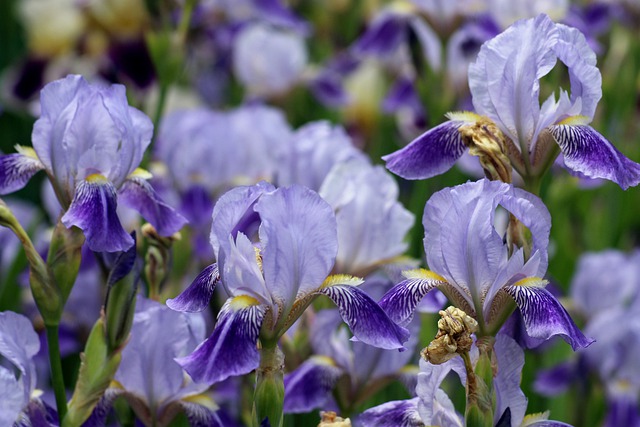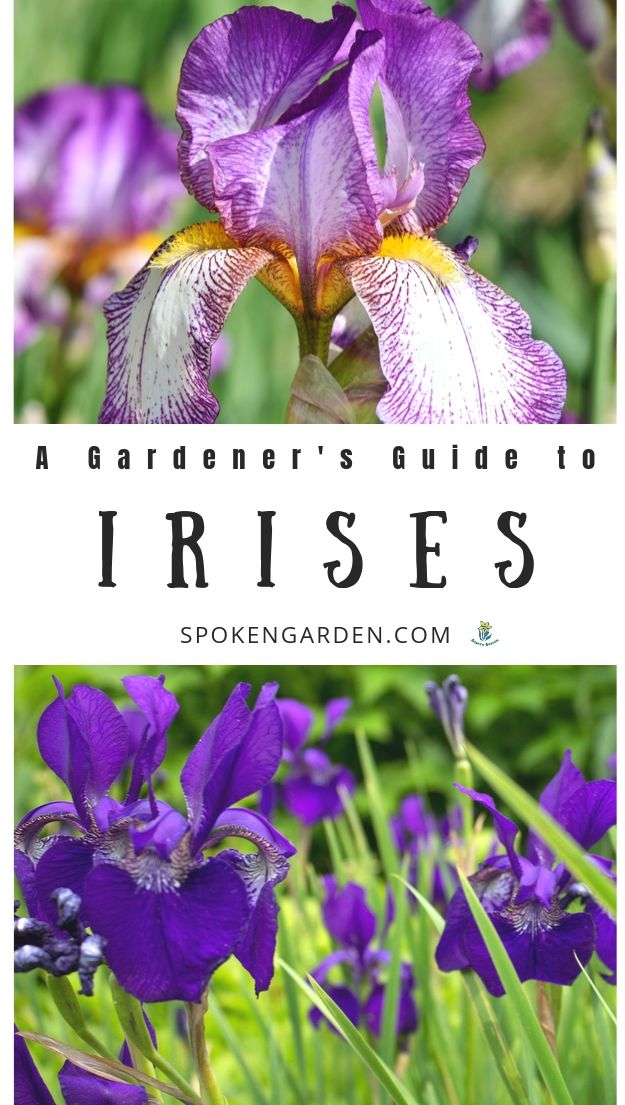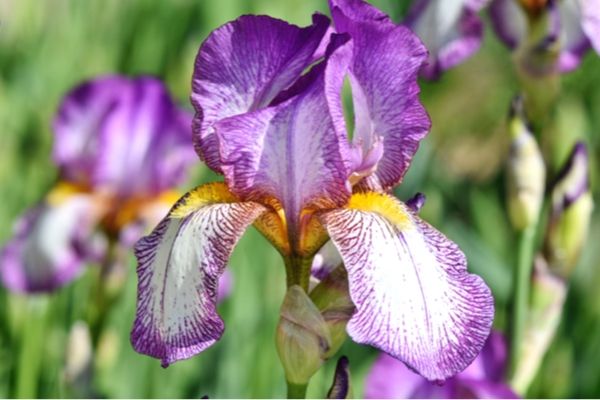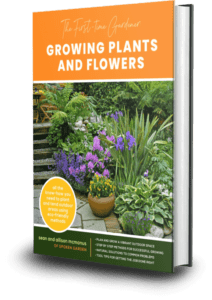Learn all about Iris (Iridaceae) in this gardener’s guide of these beautiful perennials, including plant care, bulb planting tips, companion plants, and more!
Want to plant a “rainbow” in your garden? Look no further than irises! Not only are they a gorgeous spring-blooming bulb, their name actually means “rainbow.”
From Bearded Iris to Dutch Iris (and more), in this Iris (Iridaceae) plant guide, you’ll learn about proper plant care for these beautiful irises including plant care, companion plants, and quick tips on how to plant iris bulbs correctly. For an even more in-depth bulb planting guide, you might be interested in checking this out.
If you’re already lucky enough to already have these bulbs in your garden but you are unsure how to best care for them, this post will teach you the skills you’ll need. Or, if you are new to gardening and want to add these to your landscape but you’re scared you might kill them with your black thumb, don’t worry! This post will teach you proper care and give you the confidence to grow and care for them.
Quick Plant Care Facts
| Sun Exposure | Vary by species. |
| Water Needs | Vary by species. Can range from moderate to excessive, depending on the specific species. |
| Soil Needs | Vary by species. |
| Cold-Hardiness Zones | USDA and Sunset vary due to Irises being well adapted and found on almost every continent of the world. |
| Bloom Time | Ranges due to variety of plants available. Can be early spring to late summer. |
| Flower Colors | Flowers come in blue, purple, white, yellow, pink, orange, brown, red, and even black, |
| Mature Height/Width | Can range from ground cover height of 8 inches all the way to 3 to 4 feet tall. |
| Plant Spacing | Vary by species. |
Become a Plant Profile Club member here, if you want more iris plant care information than this!
[convertkit form=1655951]
If you are looking for Summer Flowering Bulbs to add to your garden, look no further than our ebook
21 Spring-Planted Bulbs For Fantastic Summer Color!
It’s has 60+ pages of summer flowering bulb inspiration and you can get to know the different plant care needs of these 21 gorgeous spring-
planted, summer-flowering bulbs. Whether you are already familiar with bulbs or are just learning about them, this guide explains what bulbs are, defines the 5 different types of bulbs, the correct planting orientation for each of the 5, and much more.
You also get to know each of these 21 spring-planted, summer-flowering bulbs intimately for their care needs like where they will grow, when they flower, different flower colors they are available in, and which online-retailers you can buy your very own to then add to your garden.
Grab your copy now and start planning your spring and summer flower garden TODAY!
If you aren’t sure where to start learning about gardening, go to our Start Here page where you can get find beginning gardener topics by listening, watching, and reading.
Iris Care
Now that you’ve learned a bit of background information about this amazing perennial, it’s time to present you with an overall guide to iris plant care to get you started with the basics.
Then, after you read the table below, keep scrolling to learn more about specific bulb planting steps, find out about three of our recommended iris bulbs, and iris companion plants.
But first, collect your free plant guide to take with you!
You can find more of iris care needs, when it flowers, its uses, and more by becoming a Plant Profile Club member.
Irises: Why We’re Featuring These Plants
First of all, irises are beautiful. Plain and simple. These spring-blooming flowers show up in a multitude of colors, such as red, pink, purple, yellow, white, and more! In addition to their beauty, Irises can be found in many different shapes and sizes. Their delicate flowers develop from one of two different types of bulbs, either rhizomatous or bulbous.
Another reason we wanted to feature irises is that they can grow just about anywhere!
Easily grown and propagated, irises can live in forest environments, meadows, wetlands, containers, and in your backyard garden beds making them extremely versatile. One interesting fact is that there are 28 species of iris native to the United States. In fact, they can be found growing naturally in every state in the U.S.!
Lastly, iris flowers will attract a host of different pollinators, including butterflies, bees, and birds, to your garden. With iris bulbs, you can create a stunning display of natural beauty that you can connect to each day in your own garden.
Many botanists and horticulturists explain how irises quite possibly put a great deal of energy into producing very large, colorful flowers on each plant in order to be the most attractive to pollinators. The large, showy flower will hopefully set them apart from all the other flowers vying for pollinators at the same time.
No matter which reason you choose to grow irises, we guarantee you can learn to plant them and care for them properly after some practice and plant care information.
Iridaceae Plants: History and Uses
As you begin your journey to understand more about irises, a good place to start is to first learn about their family group, their history, and their uses. Read on below for more!
Iridaceae Family
Irises are in the Iridaceae family. Also known as the iris family, this family group has more than 300 species of flowering plants throughout the world!
The iris family features some of the most popular flowers in the world including quite a few you have probably heard of before.
Iris family members are valued for a range of uses, including:
- Cut flowers
- Ornamental gardens
- Perfumes
- Aromatherapy
- Gins
- Other medicinal uses
Other members of the large Iridaceae family include Gladiolus, Crocus, and Freesias.
Iris History
Irises are native to Europe and Asia but they’re origin dates back as far as 1469 BC and ancient Egypt.
Once a symbol of power, the iris flower, and its shape were the inspiration for the fleur-de-lis.
Irises are infamous in Greek mythology and symbolize an important “messenger” between the Greek Gods and the Earth. This messenger was a Greek goddess, named Iris, who traveled on a rainbow delivering messages to the mortals. As the legend states, wherever Iris touched the Earth, beautiful, colorful flowers would show up.
As is the case with most of our other favorite flowers and their evolution, irises made their way to the United States by way of the European settlers. They may have been planted in Virginia as early as the 1600s.
Today, irises are mainly grown for their ornamental value in all types of gardens around the world.
Iris Uses
Irises can be used for many different reasons. In ancient Egyptian times, they were first used in perfumes and medicine.
Orris root, extracted from the dried root of a Bearded Iris, is one of the main parts of the iris that is cultivated and used today. Also known by the name “Queen Elizabeth Root,” this dried part is extracted mainly from either the Iris germanica or the Iris pallida species and is used several ways, including:
Examples of uses for Orris root include:
- Perfumes
- Aromatherapy
- Gin
- Medicinal
- Flavoring syrups
- Cosmetics
As stated previously, irises are mainly prized today for their ornamental value in home gardens.
How to Plant Iris Bulbs

The two types are 1) Rhizomatous, and 2) Bulbous. Depending on the type of bulb you want to plant, it will determine the planting depth. For example, bulbous types, like Dutch Irises, are usually planted at a 4-5″ depth. Rhizomatous types, like the Bearded Irises, are different though because they are rhizomes. They should be planted in a shallow trench slightly below the surface. If you plant them too deeply, they can’t find their way to the surface which would be very unfortunate
Irises are arguably one of the most beautiful spring-flowering plants. If you are thinking about adding them to your garden, then you should think about getting them planted anytime between July and September, as this is the prime time to do so with night-time temps at or above 40-50° F.
Iris planting steps (for rhizomes):
- Find the right location with at least 6 hours of sunlight a day.
- Dig a shallow planting hole about 4 inches deep and 10 inches wide.
- Space each rhizome 1 to 2 feet apart and plant singly or in groups of three.
- Lay the rhizome horizontally at the base of the hole with the leaf-like end pointing down.
- Refill the planting hole where the Iris top is at or just above the soil level.
- Add some bulb fertilizer.
- Water thoroughly.
You can find more of iris care needs, when it flowers, its uses, and more by becoming a Plant Profile Club member.
Iris Companion Plants
Since Irises can grow just about anywhere, they have a lot of other spring-blooming friends.
Being a native plant from Europe and Asia, this plant has a great ability to adapt to different climates and can be lower maintenance than most other landscape plants. They prefer companions with similar bloom times, sunlight and watering needs.
Irises and most of the companion plants listed below will add color and a continuous supply of beneficial food sources to your landscape all spring and summer season. Meaning, the pollinators love them and they will flock to your garden which is a HUGE bonus.
- Asters
- Crocus
- Alliums
- Agapanthus
- Chrysanthemums
- Daffodils
- Tulips
- Alliums
- Columbine
- Salvia
- Phlox
Best Iris Bulbs to Plant This Fall
If you’re in the market for suggestions, these three iris options below would be perfect for you. All three will bloom in next spring’s garden! By the way, we only suggest products that we have used ourselves or that have been highly recommended by other gardeners or landscape professionals. For all the bulbs below, we have a deal for you through one of our favorite suppliers, Eden Brothers.
When you get to the Eden Brothers checkout, because we are affiliates (which means we receive a small commission at no cost to you which helps us run our website and podcast), use our special coupon code “SPOKEN” for an extra 15% off your order!! By the way, if you order through any of our links we’ll get a small commission that helps us run our blog and podcast so we can bring you great content! Thank you for considering that.
1) Best Multi-Colored Option = Bearded Iris Bulb Mix
This beautiful Iris bulb mix is amazing and full of color! This perennial mix would be perfect for you if you are looking for a lot of colors, variety, and tall flowers.
Choose from a multi-colored bag of 5, 10, or 25 bulbs to add to your landscape. Click the image or the “shop now” button below the image to find out more!
2) Best Deer-Resistant Option = Dutch Iris Bulbs ‘Lion King‘
Another great option for you would be these Dutch Iris bulbs. Really, the name of this variety just screams “add me to your garden!” These bulbs bloom in gorgeous hues of yellow, orange, and even purple and will grow to a height of almost 2 ft. tall!
Choose from a bag of 25, 50, or even 100 bulbs to add to your landscape. Oh, and of course, they are deer-resistant!
3) Best Fragrant Option = Re-Blooming Bearded Iris Bulbs ‘Clarence‘
This re-blooming Bearded Iris option would be perfect for you if you like tall, fragrant flowers. A huge bonus for this variety is they are also deer-resistant and slightly drought-tolerant.
These flowers will bloom in a gorgeous light blue and will grow to a height of almost 3 ft. tall! Choose from a bag of 2, 4, or 10 bulbs to add to your landscape (although you might need to double up or divide your bulbs because odd-numbered groupings generally look best in your landscape).
Bulb Planting Tools and Books
If you are ready to attack your iris bulb planting, you may be wondering what tools you could use to plant your bulbs quickly. Luckily, you will only need a few new tools to get the job done. Below we have gathered a few tools and supplies as well as a couple of books that we thought would be useful for you as you prepare to plant your garden bulbs this fall.
We have two tool options for you to consider:
1) For Digging By Hand
If you want to get some exercise, be one with nature, and hand-dig all your new bulb holes, this Tabor Tools 3-piece bulb planting tool set is perfect for you. This toolset includes a bulb planter, a dibber, and a transplanter. The premarked depths on the planter make it really easy to ensure the correct bulb-planting depth which we really appreciate.
This hand-digging method using these tools will take you a bit of time on your hands and knees digging holes (again, depending on how many bulbs you need to plant).
However, if you want to save some time, then you need to consider this other tool!
2) For Faster Bulb Planting
This bulb and bedding plant auger. You will still get some exercise, but if you have less time to work in the yard and/or you have tons of bulbs to plant (like we do this year), then this drill bit is EXACTLY what you need! Using the 3/8 drill bit, this tool can dig holes in all kinds of dirt in so much less time!
Other Recommended Supplies:
Bulb Planting Books
If you’re looking for further educational resources about all types of bulbs and other plants, these books below are great educational references!
The first book is one of our new eBooks which we’re so excited to show you! The two books below that can be found on Amazon at the links below.
Planting Garden Bulbs
Don’t gamble on your bulb’s chance of survival. Learn to plant it right the first time!
This mini eBook is chock full of helpful tips and tricks combined with our time-tested garden maintenance experience from over 20+ years of professional landscape experience. If you want to find out more about the book, check out this page.
American Horticultural Society Encyclopedia of Plants and Flowers
This is a great reference guide for tons of different perennial and annual plants from the American Horticultural Society.

Floret Farm’s Cut Flower Garden: Grow, Harvest, and Arrange Stunning Seasonal Blooms
This book has stunning images, how-tos, and planting information to grow your own cutting garden. Learn what to do now so you are ready for spring and summer!

Video About Iris Care
In order to help you learn more about Irises, check out the video below. We hope it is helpful!
Iris Plant Care Conclusion
Irises will enhance your landscape in so many ways. With all the beautiful colors, sizes, and types available, you really cannot go wrong. Plus, the pollinators will flock to your garden!
With our plant care guide, quick bulb planting tips, tool suggestions, and books you should be all ready to plant your Iris bulbs this fall!
Now we want to hear from you!
What questions do you still have about Irises? Let us know by leaving a quick comment below. Thanks!
Want to learn about other plants in your garden? Check out some of our previous plant profiles:
- Daffodils: A Gardener’s Guide and Plant Profile
- Crocosmia: A Gardener’s Guide and Plant Profile
- Primroses: A Gardener’s Guide and Plant Profile
- Tulips: A Gardener’s Guide and Plant Profile
- Grape Hyacinth: A Gardener’s Guide and Plant Profile
- Sunflowers: A Gardener’s Guide and Plant Profile
See you in the garden!
~ Sean and Allison
P.S. Find us on Pinterest, Twitter, Facebook, and Instagram so you don’t miss a thing!
Iris (Iridaceae) References:
- Growing Irises – Old Farmer’s Almanac
- American Iris Society
- Irises For the Home Landscape – Iowa State University Extension & Outreach
- Iris: A Brief History – University of Missouri
- Our Native Irises – USDA

Click the graphic above to save “Iris Plant Profile” to Pinterest for later!
Learn all about Iris (Iridaceae) in this gardener’s guide of these beautiful perennials, including plant care, companion plants, medicinal uses, and more.








